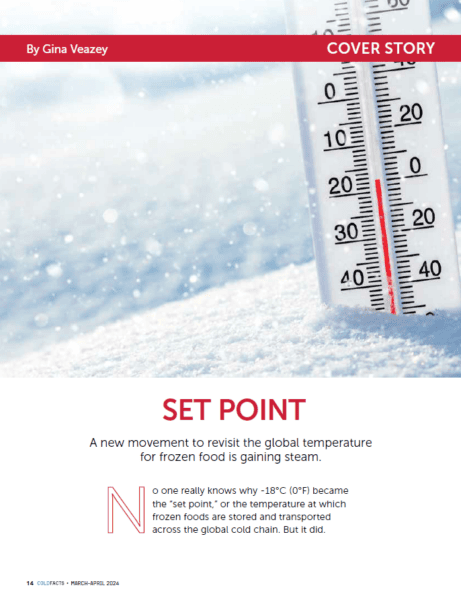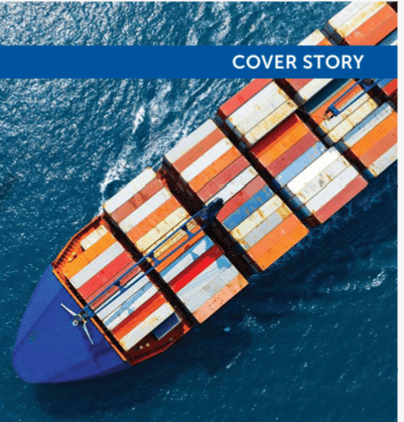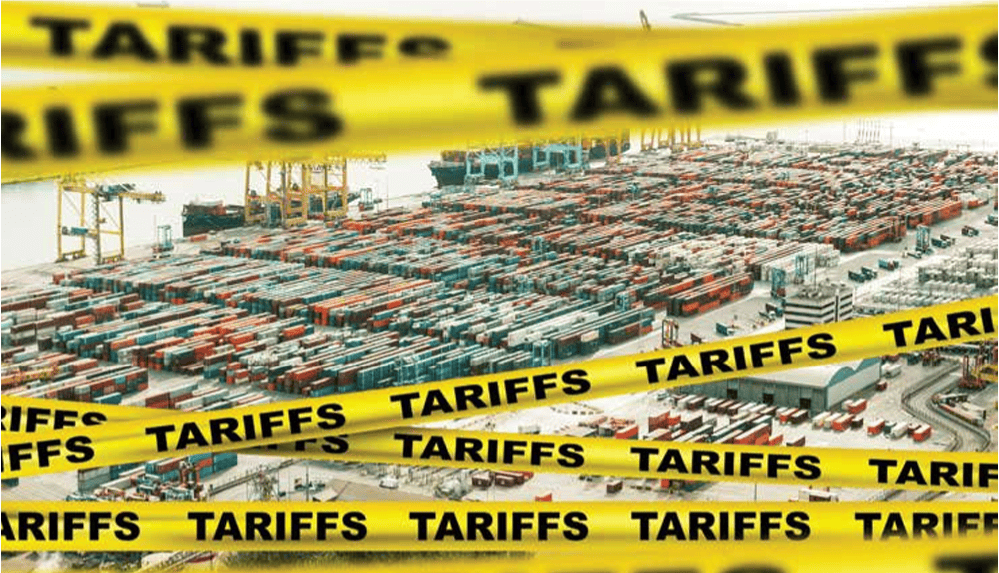From COLD FACTS Magazine (Click Image)
Read Below:
Set Point
A new movement to revisit the global temperature for frozen food is gaining steam.
By Gina Veazey
No one really knows why -18°C (0°F) became the “set point,” or the temperature at which frozen foods are stored and transported across the global cold chain. But it did. Many people point to 1924 and discoveries by Clarence Birdseye, who developed methods for quick-freezing pre-packaged food. His innovations earned 168 patents covering the novel freezing and packaging techniques, packaging material and more.
“The set point temperature has been -18°C for almost a century,” observes Dr. Yosr Allouche, Director General of the International Institute of Refrigeration (IIR). “It has been proved to be a safe way to store and deliver quality food.”
The Codex Alimentarius, a collection of international standards, guidelines and codes of practice for the food trade, broadly defines “frozen” as -18°C or below. Although it calls for many foods to be maintained at this standard temperature, its standards are voluntary. They are not enforceable until lawmakers or regulators mandate them. Codex standards are, however, commonly used as a point of reference by regulators, lawmakers and standard setting bodies around the world.
In some cases, customs, commercial contracts and agreements covenants, and even company policies depart from the Codex. Some call for a temperature below that recommended by the Codex. In the European Union, many countries specify a “maximum permitted temperature” of -12° (10oF), considerably higher than the -18°C recommended by the Codex.
Energy Savings
With few exceptions, it is believed that most frozen foods don’t need to be held at -18°C. When the temperature is well controlled throughout the cold chain, neither food quality nor food safety is negatively affected by a temperature of -15°C or higher.
Storage and transportation temperatures below -12°C are thought to provide a sizable margin for error. In the United Kingdom, for example, Cold Chain Federation Executive Director Tom Southall reports that most cold stores and vehicles operate at -20°C to -25°C. This, he says, is “to build in tolerance against equipment failure or temporary exposure to heat.”
But this margin of error comes at a high price. For every degree below -12°C, it has been estimated that an additional 2% to 3% of energy is required to maintain food temperature. Recent volatility in U.K. energy prices, Southall says, as well as the strong drive towards Net Zero – in the United Kingdom and across the EU – have CCF members “laser focused on energy efficiency through temperature-controlled logistics.”
“We have generated an enormous amount of wasted energy in the last 100 years before we actually realized we didn’t have to do this,” says DP World’s Dirk Hoffmann, Account Director for Reefer Supply Chain Services in the United Kingdom. “With the increase of the cost of energy, the demand for energy, in particular electricity, has certainly made it more acute that we need to look at things from a different perspective.”
Is Now the Time?
This conversation about the set point – and the potential to reduce costs and cut energy consumption by raising it 3-degrees Celsius – is not new. But it is different.
Renewed interest in a higher set point is increasingly coming from cold chain customers. Food manufacturers have already begun to study how a -15°C cold chain set-point temperature would impact their products.
Some, like Nomad Foods’ Georgios Tetradis-Mairis, who is the company’s Head of Research and Development, approach the conversation with a sense of urgency. “We know that failure to mitigate the worst impacts of climate change not only threatens lives and livelihoods across the world but could materially impact many businesses. Therefore, every food business must play its part in reducing greenhouse gas emissions across the value chain.”
Unilever, one of the biggest ice cream makers in the world, is working to perfect new formulations that allow its products to be stored and transported at -12°C or higher. The company says the change, up from its longtime set point of -18°C, equates to a 20% to 30% energy savings across its supply chain and retail freezer footprint. It has already completed a successful pilot in Germany and is launching another, larger pilot in Indonesia.
Similarly, Nomad Foods, the owner of Birds Eye, as well as Green Cuisine, Findus and Iglo, has investigated the potential to store its frozen foods at a higher temperature. In March 2024, the company released the latest update from an ongoing study that found a storage temperature of -15°C could reduce freezer energy consumption by 10% without affecting product safety, texture, taste or nutrition.
“We have the potential to significantly reduce energy use when storing frozen products, without reformulating,” explains Tetradis-Mairis. “Delivered at scale, this could revolutionize our industry and deliver substantial energy use and cost reductions for manufacturers, food retailers and consumers and further reduce the carbon footprint of frozen food products.
Food Loss and Waste
Beyond energy consumption, Dr. Stephen Neel, Vice President of Global Food Optimization at Lineage Logistics, reasons that frozen foods are an important part of the food ecosystem because they can help reduce food loss and waste. He points to research from the British Food Journal, which concluded that frozen foods generated 47% less food waste in the homes of consumers who participated in the study, as compared to ambient and chilled food.
More than one-third of food produced for human consumption is lost (14%) or wasted (17%), according to the Food and Agriculture Organization of the United Nations. This comes at an estimated cost of $936 billion annually.
Wasted food is also a waste of the land it is grown on, along with water, labor and other increasingly scarce resources. As food waste breaks down in landfills, it adds to the greenhouse gas problem that is the root cause of the effects from climate change.
“Increasing access to food does not require more food production, rather it’s a matter of ensuring that the food we have reaches people in a safe condition for consumption,” Neel adds. “We believe freezing more of our food would help increase accessibility by smoothing out the effects of seasonality and allow current production levels to feed more of the world, even in the face of an increasing population and a supply chain facing geopolitical challenges.”
Nonetheless, Neel acknowledges that “optimizing the utilization of food and increasing the amount of food that is temperature controlled in our system may result in higher energy costs for the industry.” Based on a study conducted by researchers at the University of Birmingham, London South Bank University and the International Institute for Refrigeration, Neel says it is believed that those costs could be offset by improved efficiency and better use of resources across the frozen food chain – without compromising food safety or quality.
Revisiting -18°C
This belief, backed by the new research, is why DP World and others including Lineage, AJC Group, A.P. Moller-Maersk, Daikin, the GCCA, Hapag-Lloyd, Kuehne + Nagel, Mediterranean Shipping Company, Ocean Network Express, Americold and Unilever, just to name a few, have signed on to The Move To -15°C. The initiative, launched at the United Nations Climate Change Conference, COP28, in Dubai, is open to the entire industry, from food production through the frozen supply chains to the end consumers.
“There’s nothing more immoral than food waste,” says Hoffmann. “Our first obligation is to make sure that consumers are protected. That will always be the number one priority in the food supply chain. So, if we say that the cold chain or the supply chain is adding any risk to consumers, then of course we shouldn’t do it. Second, does it contribute to food waste or unnecessary food spoilage? If the answer is yes, then of course we shouldn’t do it.”
But, Hoffmann continues, “If the answer is no to those things, then we have reason to change the temperature for storing food products at a slightly higher temperature to reduce the amount of emissions that is generated to keep the product cold.”
Many questions remain. Peer-reviewed scientific evidence of the safety, cost-savings opportunity and the impacts on the environment and food security is needed.
“I believe the role played by frozen food to achieve food security and resilience, the potential energy wins associated to the 3 degrees as well as the technological progress, such as instantaneous temperature-controlled logistics, smart controls and time-temperature integrators, makes this initiative worthwhile to investigate,” Allouche says. “However, scientific evidence on food quality and practical storage life is needed to move forward with this initiative.”
World Stage
Last year, at the United Nations Climate Change Conference, COP28, a cold chain delegation presented research and led discussions on the merits of moving to a -15°C set point. Some of the world’s leading experts on climate change participated.
An international team of scientists presented a study, “Three Degrees of Change,” backed by DP World. It found that the move from -18°C to -15°C could safely reduce food loss and cut carbon emissions by 17.7 million metric tons of carbon dioxide per year.
DP World and other collaborators, including GCCA, participated in a COP28 session on the new technologies that could make this the right time to give the move to -15°C serious consideration.
“Cold chain operators serve their customers, they meet the customers’ specifications and requirements,” says GCCA’s Shane Brennan, Senior Vice President for Global Communications. “We will always be the followers, to a certain extent, of the industry practice, because we provide solutions in line with the rules laid down by regulators and our customers. Nonetheless we have an obligation to look at how we can do this in the most resource-efficient way possible. We wanted to bring expertise and practical logistical knowledge to COP28 and show our support for the process and journey to see what will be achieved.”
Brennan says participating in COP28 gave GCCA an opportunity to educate the world about the value of frozen food. “One of the things that actually comes alongside this is reminding everybody in the sustainability world of just how valuable frozen food is as a frontline against climate change.”
Farm to Fork
Beyond the need for more robust scientific evidence, perhaps the most vexing challenge ahead for this movement is managing change across a global industry. Participants in the coalition are clear about the need for alignment from farm to fork, as Hoffmann puts it. Although industry-level organizations, including GCCA, are involved in the coalition, Hoffmann observes that there is no single entity looking at the full supply chain – and he wants this to change.
“The frozen supply chain is like a relay race as the products are handed over from one entity in the supply chain, starting with food producers to end users,” says Hoffmann. “If any of the ‘runners’ in the race cannot change the temperature setting from -18°C to -15°C, then the temperature setting reverts back to -18°C.”
Hoffmann also notes that policies, legislation and laws may need to be changed across the many trading countries in the world. “At the end of the day, this is an initiative that will only succeed if we all work together,” he says.
Tetradis-Mairis, who also stresses the importance of industry-wide collaboration, says he hopes that “we can come together and build on Clarence Birdseye’s legacy, transforming the next 100 years and beyond for the frozen category. There’s no doubt that it will be a challenge, but we are very excited by the opportunity that lies ahead.”




